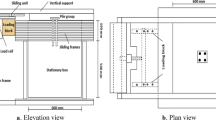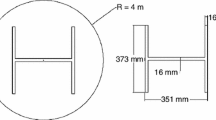Abstract
The safe and economical design of pile foundations are particularly important due to their usage in sensitive structures. This research aims to investigate soil–pile interaction using the numerical method and will provide greater familiarity with force distribution in deformation mechanisms in the soil as well as soil–pile interaction. Mohr–Coulomb model was used as the behavioral pattern. This model poorly applies the effects of soil anisotropy on mathematical relations. Therefore, this constitutive model was formulated within the multi-laminate framework which is of the great importance and value among different methods for material behavior modeling. This model can predict complex behavioral features, the effect of the principal stress axes rotation during plastic deformations, and prediction capability of the failure mechanism direction. The model is capable of predicting softening behavior of the soil in a reasonable manner due to using unconventional plasticity. The influences of induced anisotropy are included in a rational way without any additional hypotheses owing to natural properties of the multi-laminate framework. Results of this model were compared with test data and reasonable agreement was found. In this research, a pile sample was considered with its characteristics examined using a computer program within the framework of non-linear finite element method and multi-laminate theory. Calibrating the appropriate parameters of contact surfaces, the soil–pile interaction was estimated. Finally using the presented curves for planes, soil deformation, strain and tension controlling mechanism were identified to determine the shear failure route and critical areas with the risk of slip occurring at the pile shaft–soil interface.













Similar content being viewed by others
References
Abass JM, Chik ZH, Taha MR (2008) Influence of pile cap thickness on the axial response of pile group. In: International conference on construction and building technology. pp 63–73
Baziar MH, Ghorbani A (2009) Small-scale model test and three-dimentional analysis of pile-raft foundation on medium-dense sand. Int J Civ Eng 7(3):161–170
Chang D, Boulanger R, Brandenberg S, Kutter B (2013) FEM analysis of dynamic soil–pile–structure interaction in liquefied and laterally spreading ground. Earthq Spectra 29(3):733–755
D’Aguiar SC, Modaresi-Farahmand-Razavi A, Alberto dos Santos J (2011) Elastoplastic constitutive modelling of soil–structure interfaces under monotonic and cyclic loading. Comput Geotech 38:430–447
Dijkstra J, Broere W, Heeres OM (2011) Numerical simulation of pile installation. Comput Geotech 38(5):612–622
Feda J (1971) Plastic potential in soil mechanics. In: Proceedings of first Bulgarian national congress on theoretical and applied mechanics, Varna, Sofia, vol 1. pp 387–399
Fioravante V (2002) On the shaft friction modelling of non-displacement piles in sand. Soils Found 42(2):23–33
Fukushima S, Tatsuoka F (1984) Strength and deformation characteristics of saturated sand at extremely low pressures. Soils Found 24(4):30–48
Galavi V, Schweiger H (2010) Nonlocal multilaminate model for strain softening analysis. Int J Geomech 10(1):30–44. doi:10.1061/(ASCE)1532-3641
Jagodnik V (2014) Bevavior of laterally loaded piles in natural sandy gravels. Ph.D. thesis, University of Rijeka Faculty of Civil Engineering
Khodair Y, Abdel-Mohti A (2014) Numerical analysis of soil–pile interaction under axial and lateral loads. Int J Concr Struct Mater 8(3):239–249
Konagai K, Ahsan R, Maruyama D (2000) Simple expression of the dynamic stiffness of grouped piles in sway motion. J Earthq Eng 4(3):355–376
Maheshwari BK, Truman KZ, Naggar M, Gould PL (2004) Three-dimentional nonlinear analysis for seismic soil–pile–structure interaction. Soil Dyn Earthq Eng 24(4):343–356
Randolph MF, Wroth CP (1979) An analysis of the vertical deformation of pile groups. Geotechnique 29(4):23–39
Sadrnejad SA, Amiri SAG (2009) A simple unconventional plasticity model with in the multi-laminate framework. Int J Civ Eng 8(2):143–158
Sadrnezhad SA, Karimpour H (2011) Drained and undrained sand behavior by multilaminate bounding surface model. Int J Civ Eng 9(2):112–125
Sadrnezhad SA, Pande GN (1989) A multilaminate model for sands. In: Proceedings of NUMOG III. London, pp 17–37
Schuller H, Schweiger HF (2002) Application of a multilaminate model to simulation of shear band formation in NATM-tunnelling. Comput Geotech 29(7):501–524
Schweiger HF, Wiltafsky C, Scharinger F, Galavi V (2009) A multilaminate framework for modelling induced and inherent anisotropy of soils. Geotechnique 59(2):67–101
Terzaghi K (1943) Theoretical soil mechanics. Wiley, NY
Zienkiewicz OC, Pande GN (1977) Time-dependent multilaminate model of rocks—a numerical study of deformation and failure of rock masses. Int J Numer Anal Geomech 1(3):219–247
Acknowledgements
The authors would like to thank the colleagues and students from department of civil engineering, Shahid Chamran University who provided insight and expertise that greatly assisted the research, although they may not agree with all of the interpretations of this paper. We would also like to show our gratitude to Dr. S.A. Sadrnejad for sharing his pearls of wisdom with us during the course of this research.
Author information
Authors and Affiliations
Corresponding author
Appendices
Appendix 1
The behavioral coefficient matrix is calculated at each integration point through numerical solutions. Since the objective of this study is to explain elastoplastic model based on multi-laminate theory to study the interaction between pile and soil, it is required to develop MULTI-LAMINATE formulation theory in FORTRAN programming framework. This code is introduced in following flowchart.
Appendix 2
The multi-laminate subroutine (written based on the mentioned theory in FORTRAN programming framework) have been implemented into finite element code employed to solve the non-linear equation system. This code is introduced in following flowcharts 1–12 which are included 12 subroutines.





Subroutines definition
- INPMD:
-
Input data
- COPRL:
-
Calculating cosines and weighted coefficient of the 13 planes
- ISTRMD:
-
Converting stresses into node forces
- LOAD:
-
Converting surface pressures and body forces into node forces
- WPLDNL:
-
Applying water pore pressure to system
- RESTSE:
-
Displacement and load increment
- ALGOR:
-
Solving step control
- STANMD:
-
Calculating required parameters to generate stiffness matrix
- GAUSS:
-
Defining point’s location and weight coefficient in local coordinate
- SFR:
-
Defining shape function and applying coordinate in Gaussian points
- JACOB:
-
Defining Jacobean matrix
- BMAT:
-
Calculating B matrix
- FRONT:
-
Solving equation system
- RESMD:
-
Calculating strain increments
- OUTPMD:
-
Output data
- DDATA and SDATA:
-
Calculating stress and strain components for each increment
Rights and permissions
About this article
Cite this article
Khorami Fard, G., Rasoolan, I. Soil–Pile Interaction Analysis Using Multi-laminate Elasto-Plastic Modelling. Geotech Geol Eng 35, 1665–1683 (2017). https://doi.org/10.1007/s10706-017-0201-4
Received:
Accepted:
Published:
Issue Date:
DOI: https://doi.org/10.1007/s10706-017-0201-4




